Santa’s little helper: what a charming phrase! It’s one that might bring to mind images of rosy-cheeked elves, flying reindeer, or the dog from the Simpsons. That’s if you don’t come from Germany, though. The country famous for its twinkling Christmas markets, gingerbread and glühwein, has its own kind of an assistant for Santa Claus. However, he’s not generally as wholesome as you might think.
Enter Knecht Ruprecht: Santa’s faithful servant who carries out his dirty work. Kids with their names on the good list have got nothing to worry about, but those on the naughty list should hide under their bed when Saint Nicholas visits, lest they get a beating from his assistant—or maybe even be carried away in his bag, never to be seen again…
The Feast of Saint Nicholas
In Germany and Austria, as well as in some other areas of Europe, December 6 is Saint Nicholas day, also known as the Feast of Saint Nicholas. It is a day dedicated to the celebration of the life of Saint Nicholas, a fourth-century Greek saint who is the patron saint of children.
On December 6, this benevolent Christmas gift-bringer, the equivalent of the modern-day figure of Santa Claus, spreads delight to the good little boys and girls of the land, handing out sweets, cakes, and gingerbread to reward their behavior during the year.
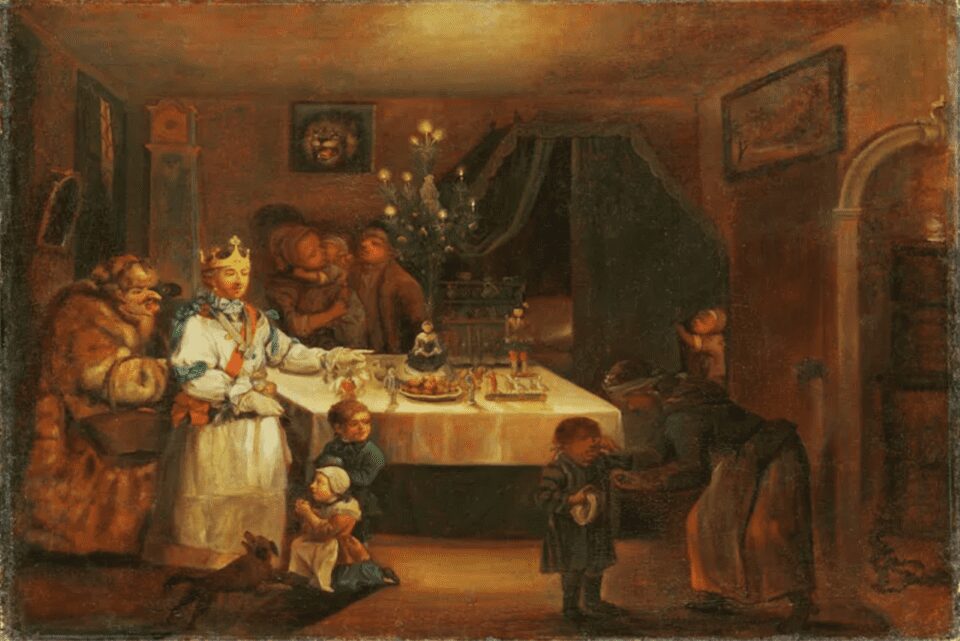
The celebration is generally a joyous one, with children eagerly awaiting the arrival of Saint Nicholas. He usually makes his entrance in the night or early morning, as he is known to ride a white horse across the sky. On the eve of the feast, children place their boots by the chimney, hoping to find them filled with treats in the morning.
But naughty children better beware, because there’s more than just a lump of coal in their stocking to punish them for their transgressions! Of course, Saint Nicholas could never get his hands dirty with dolling out punishments: he’s a holy man, after all! But that’s why he tends to visit with a personal assistant of his, one who has no such misgivings.
Knecht Ruprecht, St Nicholas’ companion
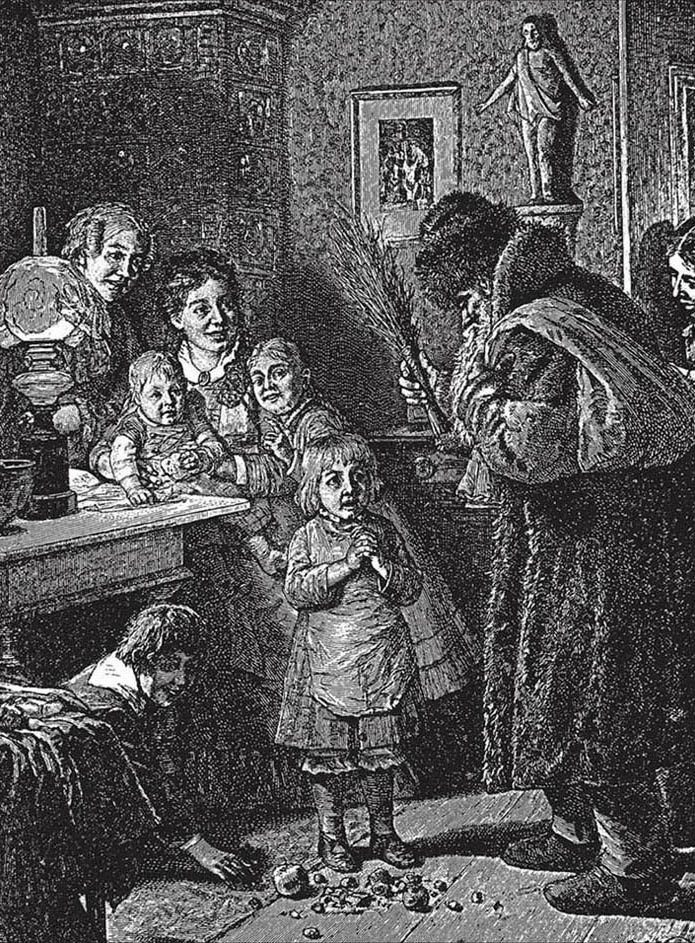
Santa’s German assistant is known by some as Ru-Klas, or “Rough Nicholas,” while others call him Aschenklas, or “Ash Nicholas.” Yet a third group knows him as Hans Ruprecht, and still others identify him as nothing less than De hêle Christ (“The Holy Christ”). However, the vast majority of people in Germany use no nicknames, but his full name: Knecht Ruprecht.
Knecht Ruprecht (literally meaning, “Farmhand Rupert” or “Servant Rupert”) is one of Santa’s many companions in traditional German folklore. He usually appears as a tall, hooded man, with a dark, bushy beard, carrying switches in one hand, and a bag of ashes in the other. He wears a black, fur robe, with chains and bells around his waist that clink and jangle menacingly as he approaches in the dead of night.
While it’s likely that stories of Knecht Ruprecht have existed in Germany ever since the Middle Ages, it’s not until the Enlightenment that we begin to find descriptions of him in any written sources. The first such description can be found in an account of a 17th-century Nuremberg Christmas procession. It’s not the only one.
In fact, his century seems to have seen quite a boom in the popularity of the myth, as this is when his legend begins to appear repeatedly in historical documents, suggesting that this is when he truly became an indispensable part of German Christmas celebrations. However, for long while, he was virtually unknown outside of Germany.
The origins of Knecht Ruprecht
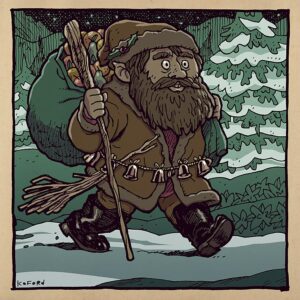
Late in the 18th century, British Romantic poet and philosopher Samuel Taylor Coleridge made Knecht Ruprecht famous in the English-speaking world through his vivid 1798 account of Christmas at Ratzeburg, a village in northern Germany.
In the brief travelogue, Coleridge describes Knecht Ruprecht as a man outfitted in “high buskins, a white robe, a mask, and an enormous flax wig.” He also says that his appearance is such that “the parents and elder children receive him with great pomp of reverence, while the little ones are most terribly frightened.” For a reason, it seems—as famous 19th-century folklorist and linguist Jacob Grimm would discover about three decades later.
Writing in Teutonic Mythology, his influential treatise on Germanic paganism, Grimm traced the origins of Knecht Ruprecht to some dark and mysterious forces from Germanic antiquity. After pointing out that the name Ruprecht was once as common name for a servant as Hans and Claus were in his days, he went on to say that before that, it must have had explicit demonic associations.
As evidence for this, Grimm drew attention to the use of several diminutive forms of Ruprecht—Rüpel, Riepel, and Rubel—in medieval European witch trials as the names for fiendish tomcats or “little young devils.” In fact, the figure of Robin Goodfellow—the mischievous sprite in English folklore, also known as “Puck”—seems to also be related to this strange German Santa, as “Robin” is the Anglicized cousin of “Ruprecht.”
A nightmare for naughty children
When Saint Nicholas and Knecht Ruprecht arrive at a house at Christmas Eve, they are usually welcomed by the family and invited in for some food and drinks. Then, just before he starts giving out gifts, Saint Nicholas checks his big book of names to see if the devil has written some bad word about any of the household’s children.
If there’s anything less than exemplary recorded, Knecht Ruprecht is invited to take over. He approaches the child, striking fear into their tiny heart, and orders them to recite the Lord’s Prayer and any other verses of scripture they might remember, to check that they’ve been listening in church.
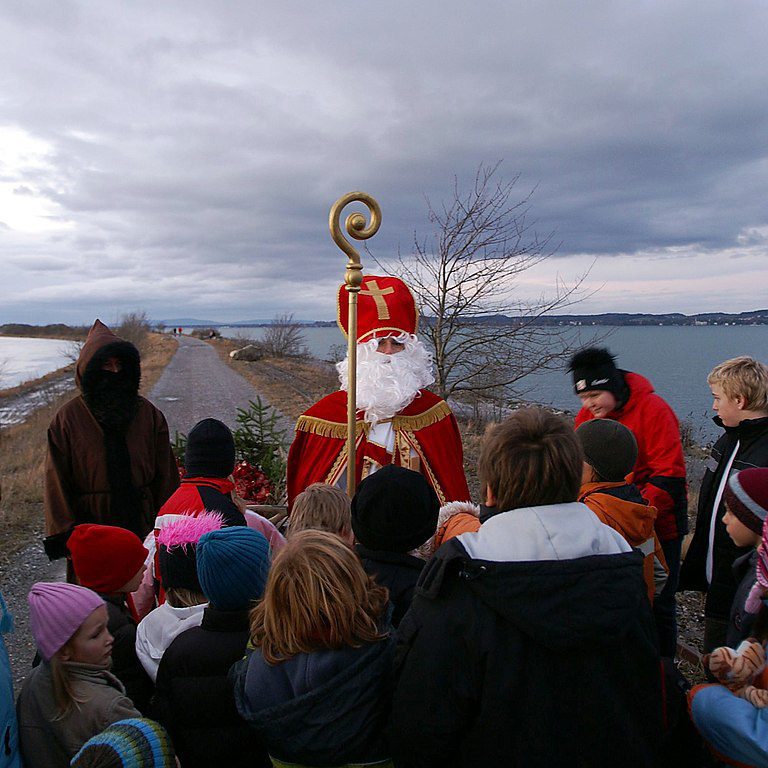
If the children cannot say their prayers, and if their behavior during the year has been particularly atrocious, Ruprecht will beat them with his stick or with his bag of ashes, to teach them a lesson for the year going forward. He’s even been said to abduct disobedient children, carrying them off in his sack, to a place of no return. In gentler traditions, Ruprecht doesn’t do the beating himself, and instead gives a rod to the parents of the naughty child, advising them to use it frequently.
While all this might seem quite harsh, these threats and scary stories are not unusual in the German tradition. In fact, if you’ve ever heard of the terrifying children’s book Struwwelpeter—which attempts to teach children moral lessons through horrifying stories of kids being mauled, abandoned, or burned to a crisp—then an evil Christmas fiend made up to intimidate children into behaving properly might not be so surprising!
Knecht Ruprecht, Krampus, and Kobolds
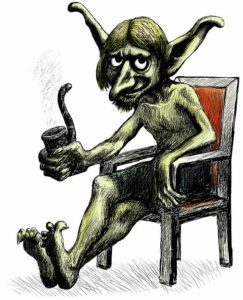
Believe it or not, Knecht Ruprecht is just one of a variety of anti-Santa figures which exist in Central and Northern Europe!
In fact, by now you may have already recognized elements of his legend from the better-known character Krampus, who terrorizes children in Austria, Slovenia, and the Czech Republic. Krampus and Knecht Ruprecht share many similarities, including their memorably haunting appearance and propensity to carry children away in a sack.
The similarity in these two myths is likely because they originated from the same, much earlier, creature common in Germanic folklore. Indeed, it’s often supposed that most Central European and German traditions of the Anti-Santa could come from stories of mischievous pre-Christian house spirits, known as Kobolds.
Kobolds often appear in human form, wearing long cloaks and carrying a long staff, similar to the bundle of twigs favored by both Krampus and Knecht Ruprecht. Jacob Grimm suggested that morphing the pagan belief in Kobolds into a Christmas demon was a way for Germanic peoples to continue practicing aspects of their ancient culture even after they converted to Christianity.
Knecht Ruprecht and Belsnickel
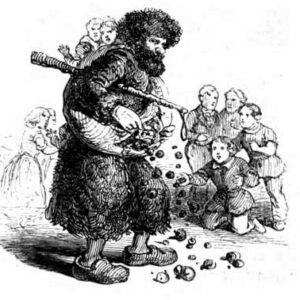
If you’re very knowledgeable about Saint Nicholas’ various counterparts from around the globe, you might also be aware of another one of the closely related figures: Belsnickel. Similar in appearance to Knecht Ruprecht, Belsnickel visits on Christmas and demands children recount their good deeds during the year, just like Knecht Ruprecht asks children to prove that they know their prayers. Moreover, he too appears as an old man with a long, fur coat and bushy beard.
The major difference between the two is that Knecht Ruprecht is usually just an assistant of Saint Nicholas and appears alongside him during his visits, while Belsnickel is said to be a sort of rival of Saint Nicholas and often appears solo. The level of similarity here should be no unsurprising, as it’s thought that the Belsnickel myth my be based on the Knecht Ruprecht figure.
While Knecht Ruprecht is rarely celebrated even in Germany in the 21st century, Belsnickel is still alive and well (if not making a comeback) among the Pennsylvania Dutch community, who brought the anti-Santa to North America in the early 19th century. We could say that the legend of Knecht Ruprecht has not dwindled. It’s just evolved.


